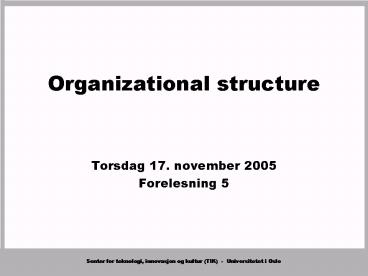Organizational structure - PowerPoint PPT Presentation
1 / 22
Title:
Organizational structure
Description:
Senter for teknologi, innovasjon og kultur (TIK) - Universitetet i Oslo ... Senter for teknologi, innovasjon og kultur (TIK) - Universitetet i Oslo. Core question ... – PowerPoint PPT presentation
Number of Views:36
Avg rating:3.0/5.0
Title: Organizational structure
1
Organizational structure
- Torsdag 17. november 2005
- Forelesning 5
2
Core question
- Which factors determine the structure of the
organization?
3
Division and coordination
- Every organized human activity from the making
of pots to the placing of a man on the moon
gives rise to two fundamental and opposing
requirements the division of labor into various
tasks to be performed, and the coordination of
these tasks to accomplish the activity. The
structure of an organization can be defined
simply as the sum total of the ways in which it
divides its labor into distinct tasks and then
achieves coordination among them. - Henry Mintzberg The Structure of Organizations
(1979)
4
Division and coordination
- Two main structures of relevance
- The division of labor
- Systems of coordination and control
5
Outline
- Core technology and structure, rational
perspectives - Natural views on structure
- Professional organizations
- Size and structure
- Networks
6
1. Core technology and structure
- The main argument
- The structuring of organizations (division of
labor and control mechanisms) is determined by
the nature of their core technology - Rational system argument (contingency theory)
7
1. Core technology and structure
- The technical core of an organization
- Define the primary outputs produced
- Follow the process by which the organization
produces these outputs from beginning to end - Include all components that are crucial for the
functioning of the production process - Technical components
- Organizational components
- Knowledge components
8
1. Core technology and structure
- Exercise
- Describe the technical core of your organization
9
1. Core technology and structure
- Three dimensions of core technology
- Complexity number of items included in the
process - Uncertainty variability of items in the process
- Interdependence connectedness of items
10
1. Core technology and structure
- Exercise
- Categorize the technical core of your
organization on the three dimensions using three
levels high, medium, low - Complexity number of items included in the
process - Uncertainty variability of items in the process
- Interdependence connectedness of items
11
1. Core technology and structure
- Organizations have different technical cores and
their structures vary accordingly - Assumptions
- High complexity ? structural differentiation
- High uncertainty ? less formalization
- High interdependence ? coordination important
12
1. Core technology and structure
- Find concrete examples of the following kinds of
organizations - Low complexity, uncertainty, interdependence
- High complexity, uncertainty, interdependence
13
1. Core technology and structure
- Basic coordination mechanisms
- Rules and programs
- Schedules
- Departmentalization
- Hierarchy
- Delegation
- Client coordination
- Primarily capable of handling moderate levels of
complexity, uncertainty and interdependence
14
1. Core technology and structure
- Advanced coordination strategies
- Reducing information (complexity, uncertainty,
interdependence) - Process organization
- Slack resources
15
1. Core technology and structure
- Advanced coordination strategies
- Increase information handling capacity
- Add systems / resources in established hierarchy
- Lateral connections
- Liaison roles
- Task forces
- Project teams
- Matrix structures
16
2. Natural views on structure
- The social shaping of technology
- The development and implementation of
technologies a result of social processes - Attacks the idea that technology determines
organizational structure - Social structures shape technology rather than
technology shaping structures
17
2. Natural views on structure
- Structures as choices
- Organizations can choose a number of different
alternative structures in a given situation - Choice will be the result of internal struggles
for power
18
2. Natural views on structure
- Informal structures
- Challenges the idea that formal organization can
solve coordination problems - Organizations need to take psychological and
social aspects of the work place into account
19
2. Natural views on structure
- Tacit knowledge
- Challenges the idea that organizations can
formalize the essential parts of their technical
cores. - Knowledge is often tacit and well functioning
routines may not be the result of formal
procedures.
20
3. Professional organizations
- The competent professional as a resource for
handling increased complexity - Professional organizations incorporate two
layers of response to task complexity complex
performers enter into and are supported and
constrained by complex organizational structures.
21
4. Size and structure
- Larger organizations tend to be more structurally
complex - Larger organizations are generally more
formalized - Formalization allows for increased
decentralization of decision making authority
22
5. Networks
- Neither market nor hierarchy
- Complimentary strengths between organizations
- Relations important
- Conflicts handled by norms of reciprocity

